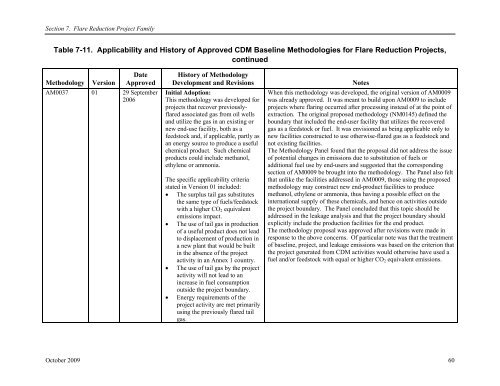Part III: Flare Reduction Project Family - IPIECA
Part III: Flare Reduction Project Family - IPIECA
Part III: Flare Reduction Project Family - IPIECA
Create successful ePaper yourself
Turn your PDF publications into a flip-book with our unique Google optimized e-Paper software.
Section 7. <strong>Flare</strong> <strong>Reduction</strong> <strong>Project</strong> <strong>Family</strong><br />
Table 7-11. Applicability and History of Approved CDM Baseline Methodologies for <strong>Flare</strong> <strong>Reduction</strong> <strong>Project</strong>s,<br />
continued<br />
Methodology Version<br />
Date<br />
Approved<br />
AM0037 01 29 September<br />
2006<br />
History of Methodology<br />
Development and Revisions<br />
Initial Adoption:<br />
This methodology was developed for<br />
projects that recover previouslyflared<br />
associated gas from oil wells<br />
and utilize the gas in an existing or<br />
new end-use facility, both as a<br />
feedstock and, if applicable, partly as<br />
an energy source to produce a useful<br />
chemical product. Such chemical<br />
products could include methanol,<br />
ethylene or ammonia.<br />
The specific applicability criteria<br />
stated in Version 01 included:<br />
• The surplus tail gas substitutes<br />
the same type of fuels/feedstock<br />
with a higher CO 2 equivalent<br />
emissions impact.<br />
• The use of tail gas in production<br />
of a useful product does not lead<br />
to displacement of production in<br />
a new plant that would be built<br />
in the absence of the project<br />
activity in an Annex 1 country.<br />
• The use of tail gas by the project<br />
activity will not lead to an<br />
increase in fuel consumption<br />
outside the project boundary.<br />
• Energy requirements of the<br />
project activity are met primarily<br />
using the previously flared tail<br />
gas.<br />
Notes<br />
When this methodology was developed, the original version of AM0009<br />
was already approved. It was meant to build upon AM0009 to include<br />
projects where flaring occurred after processing instead of at the point of<br />
extraction. The original proposed methodology (NM0145) defined the<br />
boundary that included the end-user facility that utilizes the recovered<br />
gas as a feedstock or fuel. It was envisioned as being applicable only to<br />
new facilities constructed to use otherwise-flared gas as a feedstock and<br />
not existing facilities.<br />
The Methodology Panel found that the proposal did not address the issue<br />
of potential changes in emissions due to substitution of fuels or<br />
additional fuel use by end-users and suggested that the corresponding<br />
section of AM0009 be brought into the methodology. The Panel also felt<br />
that unlike the facilities addressed in AM0009, those using the proposed<br />
methodology may construct new end-product facilities to produce<br />
methanol, ethylene or ammonia, thus having a possible effect on the<br />
international supply of these chemicals, and hence on activities outside<br />
the project boundary. The Panel concluded that this topic should be<br />
addressed in the leakage analysis and that the project boundary should<br />
explicitly include the production facilities for the end product.<br />
The methodology proposal was approved after revisions were made in<br />
response to the above concerns. Of particular note was that the treatment<br />
of baseline, project, and leakage emissions was based on the criterion that<br />
the project generated from CDM activities would otherwise have used a<br />
fuel and/or feedstock with equal or higher CO 2 equivalent emissions.<br />
October 2009 60

















